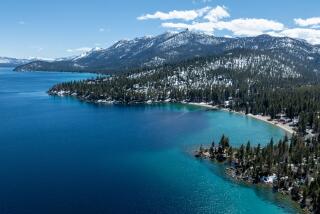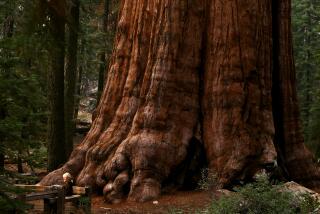Study Offers Hope for Lake Tahoe
- Share via
The renowned water clarity in Lake Tahoe can be returned to its historic 100 feet of visibility by cutting pollution by about 35% from runoff, chimney soot, dust and emissions from cars and trucks, according to UC Davis researchers who are conducting a study for state water officials.
Their initial findings, to be announced today by the state’s Lahontan Regional Water Quality Board, are expected to trigger public debate over how to achieve such a significant reduction in the mountain resort community that has at least 3 million visitors a year and already has an array of anti-pollution measures in force.
One regional planning official said the study, which is to be finalized in October, might prompt new efforts to keep sediment from flowing into the lake, expand public transportation, use biomass facilities to burn brush left over from tree thinning and even limit fertilizer used on lawns and athletic fields.
The researchers do not specify how much each type of pollution needs to be reduced, but say they believe that an overall reduction of roughly a third not only would halt the degradation of Tahoe’s cobalt-blue waters but could restore the lake’s historic clarity over several years.
“We are truly charting new territory in our quest to protect a national treasure,” said Harold Singer, executive officer of the Lahontan Regional Water Quality Control Board.
Visibility in the lake was about 100 feet in the 1970s, but had declined to 74 feet by 2004, according to the UC Davis Tahoe Environmental Research Center.
The main culprits are dirt, dust and other fine particles, said Geoffrey Schladow, the center’s director. “There are several pollutants ... coming from streams, urban runoff ... atmospheric inputs from cars, and car tires kicking up dust. And we have dust input from the Central Valley, the Bay Area and even Mongolia in Asia.”
Schladow said that a reversal could be accomplished by reducing fine sediment, nitrogen and phosphorous from groundwater, stream channel erosion, airborne deposits and runoff from urban areas and the forest. Nitrogen and phosphorus are nutrients that promote algae growth, and fine sediment becomes suspended in water, making it less clear.
The research findings are based on computer modeling, as well as a study of sediment from the lake bottom, which showed that pollution from past activities, such as logging during the mid-1800s, settled out more quickly than previously thought.
Officials said the data would help decision-makers figure out how to accomplish the reduction in pollution, which has been the subject of numerous studies in recent decades.
John Singlaub, executive director of the Tahoe Regional Planning Agency, said: “It’s exciting to have the data that show it’s possible to restore Tahoe’s water clarity to historic levels within our lifetime. We’ll have many tough decisions to make about how to achieve the goal, but to know it’s scientifically possible is a breakthrough.”
Attempts to preserve Tahoe’s clear water have largely involved limiting runoff by reducing construction and traffic and restoring wetlands and waterways to help prevent contaminants from reaching the lake.
The water clarity study is part of a joint California-Nevada effort to establish allowable levels of pollutants to meet water quality standards under the federal Clean Water Act. Officials expect that the study will be useful as they develop long-range plans to preserve the Tahoe Basin’s environment.
The next step in improving the lake’s clarity, Singlaub said, will be to determine where to focus pollution reduction efforts. He said it would make sense to concentrate on the Upper Truckee River watershed, which he said contributes much of the fine sediment in the lake.
But he also said the region needed to discuss stricter controls of nitrogen fertilizers. “We have not put restrictions on individual homeowners and have not looked at artificial turf for athletic fields,” he said.
Reducing nitrogen emissions from cars and boats would be a challenge, Singlaub said. “What it reinforces is the need for a major investment in public transportation in getting people in and out of the basin, and within the basin once they are here.”
Oregon State University professor Robert Collier, who has studied water clarity loss at Crater Lake, said he has not seen the UC Davis analysis but believes that it is on the right track.
“Now whether one could achieve about a 35% reduction with all the people that live in the basin, I do not know,” he said. “It will be a big problem to get a number that is that big. Suspended sediment in general is a difficult one to control.”
More to Read
Sign up for Essential California
The most important California stories and recommendations in your inbox every morning.
You may occasionally receive promotional content from the Los Angeles Times.










